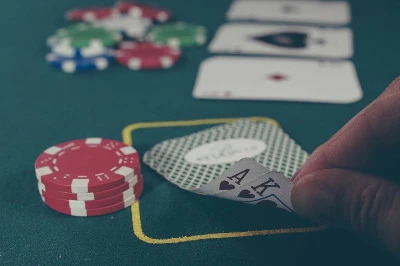
8
Mar, 2020
by sixmaxer
|
Mar 8, 2020
|
strategy
|
0 comments
The Rule of 4 and 2
The rule of 4 and 2 is a really simple way to estimate your chances of hitting one of the cards you need to make your hand the winning hand, which again will help you determine if the price you have to pay, to see the next card is right.
Had there been 100 pieces in a deck of cards in a poker game, the chance of hitting one of these cards would be exactly 1%. If there were only 50 pieces in a normal deck of cards, you would have a chance of exactly 2% of hitting each card.
As there are 52 cards in a normal deck, the chance of hitting one specific card is very close to 2%. It is not accurate - but it is plenty good enough for quick calculations and at the table estimations.
In real life, the most likely scenario however is that there are more than one card, that can provide you with the winning hand. These cards are called outs.
So for each remaining street, you can multiply the number of outs by the 2%. If you are on the flop, you have two streets remaining (the turn and the river). If you are on the turn, there is only one remaining street (the river)
The formula to calculate your chance of hitting your card is: number of outs x the 2% chance to hit any one card x remaining streets.
On the flop: There are 2 remaining streets. Multiply the remaining streets (2) by the chance to hit one of your outs (2%): and you get: 2 x 2 = 4.
So on the flop, you have a 4% chance to hit one of your outs, provided you see both the turn and the river. To guestimate your equity on the flop, you simply multiply the number 4 by the number of outs you have. If you have e.g. 10 outs, your estimated equity is: 4 x 10 = 40%.
On the turn: There is only 1 street remaining. You still have a 2% chance to hit anyone of your outs. Multiply your remaining street (1) by the chance to hit one of your outs, and you get: 1 x 2 = 2.
So on the turn, you have a 2% chance to hit one of your outs. Multiply your outs by 2 to calculate your chances to hit the winning hand.
On the flop you multiply your outs with 4.
On the turn you multiply your outs with 2.
There you have it. The rule of 4 and 2 in very simple math.
Obviously the formula is only valid, if you will actually see all the remaining streets. If you have to fold before the hand gets to the river, then you do not have 4 times your outs on the flop.
So on the flop, you have a 4% chance to hit one of your outs, provided you see both the turn and the river. To guestimate your equity on the flop, you simply multiply the number 4 by the number of outs you have. If you have e.g. 10 outs, your estimated equity is: 4 x 10 = 40%.
On the turn: There is only 1 street remaining. You still have a 2% chance to hit anyone of your outs. Multiply your remaining street (1) by the chance to hit one of your outs, and you get: 1 x 2 = 2.
So on the turn, you have a 2% chance to hit one of your outs. Multiply your outs by 2 to calculate your chances to hit the winning hand.
On the flop you multiply your outs with 4.
On the turn you multiply your outs with 2.
There you have it. The rule of 4 and 2 in very simple math.
Obviously the formula is only valid, if you will actually see all the remaining streets. If you have to fold before the hand gets to the river, then you do not have 4 times your outs on the flop.
An example
Example: You see the flop, and you have 10 outs:
There is a 10 x 2% = 20% chance, that you will hit one of your outs on the turn.
There is an additional 10 x 2% = 20% chance, that you will hit one of your outs on the river.
So, on the flop, you have (roughly) 40% (the 20% from the turn and the 20% from the river) chance of hitting one of your outs - provided you see both remaining streets.
On the turn, you have (roughly) 20% chance of hitting one of your outs - going to the river.
Let's say you are drawing to the A-high nut flush draw in spades. You have two spades - with no straight draw. Let us assume that any spade on the turn or on the river, will give you the nuts. You have two spades, and there are two more on the flop. That means there are 13 - 4 = 9 spades left in play, that will give you the nuts. So following the rule of two and four, you have 9 x 2 x 2 = 36% chance of hitting your card when on the flop, and you have a 9 x 2 x 1 = 18% chance of hitting your card when on the turn.
There is a 10 x 2% = 20% chance, that you will hit one of your outs on the turn.
There is an additional 10 x 2% = 20% chance, that you will hit one of your outs on the river.
So, on the flop, you have (roughly) 40% (the 20% from the turn and the 20% from the river) chance of hitting one of your outs - provided you see both remaining streets.
On the turn, you have (roughly) 20% chance of hitting one of your outs - going to the river.
Let's say you are drawing to the A-high nut flush draw in spades. You have two spades - with no straight draw. Let us assume that any spade on the turn or on the river, will give you the nuts. You have two spades, and there are two more on the flop. That means there are 13 - 4 = 9 spades left in play, that will give you the nuts. So following the rule of two and four, you have 9 x 2 x 2 = 36% chance of hitting your card when on the flop, and you have a 9 x 2 x 1 = 18% chance of hitting your card when on the turn.
Is the price right?
Now that you know your chances for hitting the winning hand, you have a chance to evaluate, if the price you have to pay to see the next street is good enough for you to stay in the pot, or if you should fold.
When playing poker, I always imagine that I am a businessman assessing several offers. If the price is right, considering the risk/award factor it is a good deal, and I make money if I accept the deal. If the price is not right, I lose money, if I accept the deal. Furthermore, if you can continuously offer a price that is too high, and get called - you will eventually make money. This is as true for poker as for everything else.
Now that you have a rough idea about your equity, you then calculate your pot odds to see if the price is right. Try to play around with some numbers in our free to use pot odds calculator, to practice your intuition on whether you should call or you should fold:
https://pokernewb.com/pot_odds.
When playing poker, I always imagine that I am a businessman assessing several offers. If the price is right, considering the risk/award factor it is a good deal, and I make money if I accept the deal. If the price is not right, I lose money, if I accept the deal. Furthermore, if you can continuously offer a price that is too high, and get called - you will eventually make money. This is as true for poker as for everything else.
Now that you have a rough idea about your equity, you then calculate your pot odds to see if the price is right. Try to play around with some numbers in our free to use pot odds calculator, to practice your intuition on whether you should call or you should fold:
https://pokernewb.com/pot_odds.
Want to comment on this article? Sign In to leave comments!
